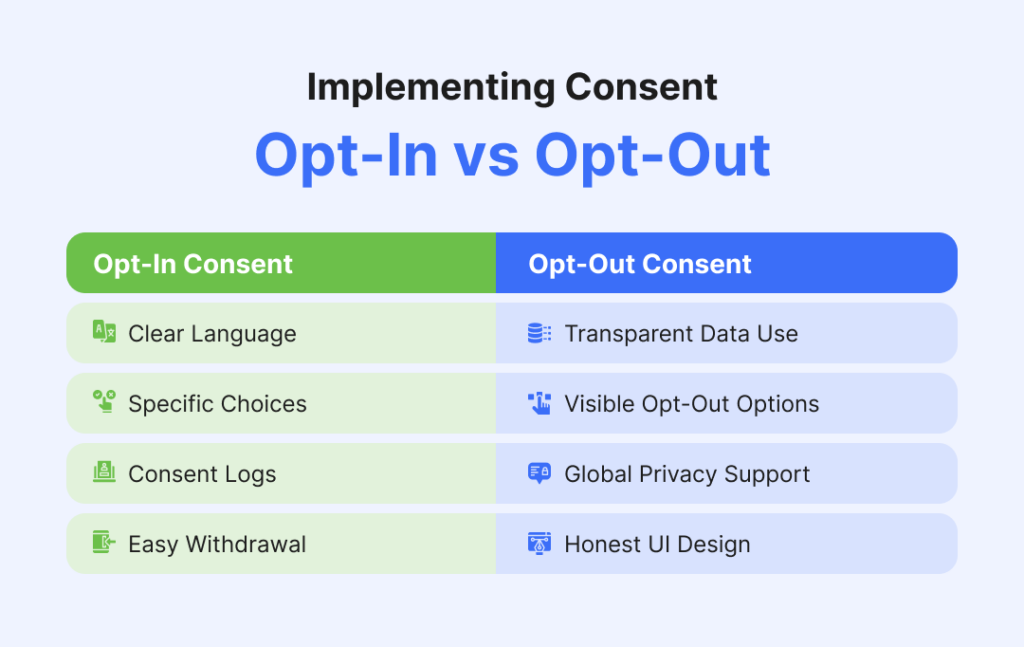How do your users agree to share their data—do they explicitly say “yes,” or are they automatically included until they say “no”? This simple choice determines your compliance with legal requirements, user trust levels, and marketing success.
In today’s privacy-driven digital world, businesses are bound to respect data rights and select the most appropriate consent model that aligns with the respective global regulations and their strategic objectives.
This blog covers what opt-in and opt-out consent mean, while discussing how major global privacy laws implement them. Whether you’re operating in the U.S., UK, EU, or any global region, this guide will help you align your strategy with legal requirements and user expectations for your business.
Consent plays a defining role in how businesses manage user data. The process of granting user permissions follows two main models: opt-in and opt-out.
Opt-in consent means users must take clear action to approve data collection, such as ticking a box or clicking “I agree.” Meanwhile, opt-out consent assumes permission is granted unless users actively reject it by unchecking a pre-filled box or selecting “No thanks.”
Understanding this difference helps you design consent flows that meet legal standards, build meaningful user relationships, and support responsible data practices.
| Example Type | Opt-In Examples | Opt-Out Examples |
|---|---|---|
| Website Consent | Click-to-accept banners | Pre-checked cookie boxes |
| Email Marketing | Unchecked newsletter signup boxes | Emails with unsubscribe links |
| Form Submission | Checkbox: "I agree to the terms." | Pre-checked subscription box |
Privacy regulations across the world vary widely in how they treat consent. Businesses must tailor their approach based on where their users are located.
The General Data Protection Regulation (GDPR) demands opt-in consent. Businesses must take freely given, detailed, informed, and clear permission before collecting or processing personal data. Pre-ticked boxes and inactivity do not count as valid consent.
If your audience includes EU or UK residents, an opt-in policy is not optional—it’s a legal requirement.
California’s Consumer Privacy Laws through the CCPA and CPRA specify user rights to opt-out or decline personal information sharing or selling. However, opt-in consent is mandatory for minors under the age of 16.
Websites must include clear “Do Not Sell or Share My Personal Information” links, allowing users to easily manage their preferences.
Businesses can send marketing emails under the CAN-SPAM Act by adding an unsubscribe option, which allows recipients to opt out of further messages. Non-compliance can result in substantial penalties.
The Children’s Online Privacy Protection Act (COPPA) mandates verified parental consent before collecting data from users under 13. This is a clear example of opt-in consent in U.S. law.
Canada’s Anti-Spam Law (CASL) enforces strict opt-in rules for sending commercial electronic messages. Express consent is the default requirement unless there is a clear existing relationship with the recipient.
Brazil’s LGPD mirrors the GDPR in its insistence on explicit opt-in consent. Data subjects must clearly agree to the process, particularly when sensitive data is involved.
Your consent strategy should reflect both your compliance requirements and business objectives. Here’s how to evaluate the fit:
Opt-in builds long-term value. It signals respect for user autonomy and aligns with regulations in stricter jurisdictions. Businesses using opt-in often see better-quality data and higher engagement, though initial conversion may be slower.
Opt-out simplifies onboarding and often results in larger user bases quickly. It’s common in regions with looser regulation, like parts of the U.S. However, it risks user backlash and potential non-compliance in global markets.
Your decision to use opt-in or opt-out models begins with a clear evaluation of essential questions. This helps ensure your approach is legally compliant and aligned with business goals.
These considerations help you assess which consent approach supports your market, user experience, and growth plans.
Understanding how to apply consent models is as important as knowing what they are. Both opt-in and opt-out methods can support compliance and enhance user trust when used correctly. Here are practical ways to implement each model effectively.
Applying these best practices ensures your consent model is effective and compliant, regardless of the regions or users you serve.

Opt-in and opt-out models go beyond just ticking legal boxes—they influence how your brand handles data and earn user confidence. A carefully chosen consent model can strengthen your compliance posture and build transparency across every user touchpoint.
Choosing the right consent model is a strategic move. It should reflect your priorities—user trust, data reach, or future scalability. Aligning with global data regulations early on ensures you’re compliant and prepared to adapt as laws evolve and your operations grow.
Power your global compliance journey with Seers AI—an advanced, AI-driven CMP that supports both opt-in and opt-out models for compliant, flexible consent management worldwide.
Users grant permission through opt-in before events occur by marking boxes, such as email subscription approvals. Under opt-out principles, users grant consent automatically until they specifically reverse it by unticking default agreement choices.
The difference comes down to who takes action—the user or the business. One gives more control up front, while the other moves faster but might feel less transparent to users.
The GDPR only allows opt-in. That means businesses must get permission before collecting or using someone’s data. No shortcuts like silent agreement or pre-ticked boxes are permitted. People need to know precisely what they agree to and choose it themselves.
If you’re handling data from the EU or UK, following this rule isn’t optional—it’s the law and protects users’ privacy by design.
Yes, you can. As per the CAN-SPAM Act, it is perfectly legal for businesses to send marketing emails without securing prior approvals as long as the consumer can easily opt out. This usually means adding an unsubscribe link in every email. It’s legal, but how you do it matters. People are more likely to stick around if you’re clear and respectful. If you make it hard to leave, they might lose trust quickly.
In most cases, yes. Opt-in puts the user in control from the beginning. They know what they’re agreeing to, and that builds confidence. It also makes your brand look more transparent.
While opt-out can grow your list faster, it can feel pushy if not handled carefully. When people feel like they have a real choice, they’re more likely to stay engaged with your brand long-term.
Getting things wrong with consent models will put you at risk. Understanding the rules under which consent is sought is essential because a local privacy law could be contravened, incurring fines or complaints. There are other reasons, too: If users feel their data was collected unfairly, they might lose trust in your business.
Thus, you must understand the laws of the land where your users live and choose a model that keeps you compliant and respectable.
Users should actively agree whenever personal data is involved, like signing up for emails or getting a marketing deal. That means they should check a box or take clear action to say “yes.” It can’t be hidden in fine print. Giving people the chance to stop and decide builds trust and keeps you safe from complaints or legal trouble down the line.
 Rimsha Zafar
Rimsha ZafarRimsha is a Senior Content Writer at Seers AI with over 5 years of experience in advanced technologies and AI-driven tools. Her expertise as a research analyst shapes clear, thoughtful insights into responsible data use, trust, and future-facing technologies.
United Kingdom
24 Holborn Viaduct
London, EC1A 2BN

Seers Group © 2025 All Rights Reserved
Terms of use | Privacy policy | Cookie Policy | Sitemap | Do Not Sell or Share My Personal Information.